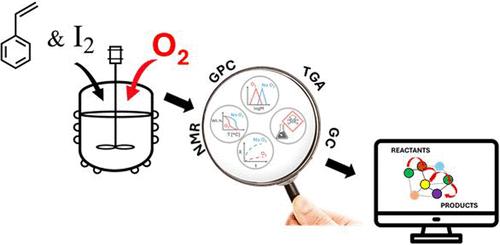氧对苯乙烯自由基聚合影响的机理研究
IF 3.9
3区 工程技术
Q2 ENGINEERING, CHEMICAL
引用次数: 0
摘要
在通过自由基聚合的聚苯乙烯的商业生产中,微量氧的存在会导致形成有毒的、挥发性的副产品,如苯甲醛和甲醛以及过氧化物,这会在聚合过程中以及随后的应用过程中引起安全问题。为了制定减少这一问题的策略,本工作探讨了氧对苯乙烯自由基聚合的影响。首先,显示了在不同氧浓度存在下一系列溶液聚合的结果。实验结果表明,虽然氧的存在对聚合速率的影响很小,但随着氧浓度的增加,生成的醛的摩尔质量显著降低,醛的浓度显著增加。为了补充实验结果,本文描述了一个数学模型,以预测氧对聚合的影响,包括不良挥发性有机化合物(VOCs)的产生,特别是苯甲醛和苯乙烯氧化物,以及摩尔质量和转化的演变。希望在未来,该模型可以帮助制定策略,以尽量减少苯乙烯自由基聚合过程中由于微量氧的存在而产生的voc的产生。本文章由计算机程序翻译,如有差异,请以英文原文为准。

A Mechanistic Study of the Influence of Oxygen on Free Radical Polymerization of Styrene
In commercial production of polystyrene by free radical polymerization, the presence of trace amounts of oxygen can lead to the formation of toxic, volatile side products such as benzaldehyde and formaldehyde as well as peroxides, which can cause safety issues during polymerization, as well as during subsequent application. In an effort to develop strategies to reduce this issue, in this work, the influence of oxygen on the radical polymerization of styrene is explored. First, results from a series of solution polymerizations in the presence of varying oxygen concentrations are shown. The experimental results reveal that while the rate of polymerization is only slightly affected by the presence of oxygen, there is a significant decrease in the molar mass and a significant increase in the concentration of aldehydes produced as the oxygen concentration increases. To complement the experimental findings, a mathematical model is described to predict the effects of oxygen on polymerization in terms of the production of undesirable volatile organic compounds (VOCs), notably benzaldehyde and styrene oxide, as well as the evolution of molar masses and conversion. It is hoped that in the future, this model can help in the development of strategies to minimize the production of VOCs resulting from the presence of trace amounts of oxygen during free radical polymerization of styrene.
求助全文
通过发布文献求助,成功后即可免费获取论文全文。
去求助
来源期刊

Industrial & Engineering Chemistry Research
工程技术-工程:化工
CiteScore
7.40
自引率
7.10%
发文量
1467
审稿时长
2.8 months
期刊介绍:
ndustrial & Engineering Chemistry, with variations in title and format, has been published since 1909 by the American Chemical Society. Industrial & Engineering Chemistry Research is a weekly publication that reports industrial and academic research in the broad fields of applied chemistry and chemical engineering with special focus on fundamentals, processes, and products.
 求助内容:
求助内容: 应助结果提醒方式:
应助结果提醒方式:


